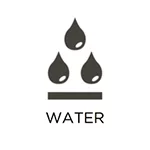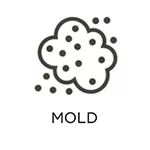RestorationMaster
Water damage is the most common form of property damage, due to the various causes. Heavy rainfall can flood a building and cause water damage, but internal problems like pipe leaks, pipe bursts, overflows, and sewage backups can result in water damage as well. Regardless of the source, immediate action is crucial to prevent further damage.
Our professional water damage restoration services at RestorationMaster can help water-damaged homes and businesses in Brick, NJ. Using advanced equipment, our technicians will extract the excess water and moisture and take action to prevent mold growth and corrosion.
Water Damage Cleanup
When excess water is in a property, porous building materials will absorb the water. The water spreads through these materials and leads to damage including discoloration, warping, swelling, and more. Without immediate action, the damage will worsen, spreading to new areas and increasing the potential for mold growth. If mold does grow, then it will result in its own damage while also presenting health concerns. Knowing this, excess water and moisture must be removed promptly.
At RestorationMaster, our technicians have the necessary certifications and training to provide excellent water damage restoration services. To do this, we use the industry’s best water extraction and drying equipment. We know how quickly water damage can cause extensive damage, which is why we have emergency services available 24/7.
Our Water Damage Restoration Services are broken down into the following phases:
- Emergency Service: Our professional technicians will arrive at your property promptly to contain and assess the damage. During the assessment, we figure out what materials need to be replaced. We then remove the water and dry affected materials using air movers and dehumidifiers. Anything permanently damaged will be discarded.
- Reinstallation and Cleaning: Following the drying process, our technicians do a thorough cleaning of the damaged areas. This will prevent corrosion, mold growth, and other common water damage aftereffects. We may need to move furniture and carpeting to ensure proper cleaning, but we will return everything to its original place once cleaning is complete.
- Structural Repairs: If the water damage has caused your residential or commercial property to suffer structural damage, then we can make repairs after the drying and cleaning is done. We will completely repair any structural elements that were damaged, such as drywall and flooring.
Contact Us 24/7 for Water Damage Restoration & Cleanup in Brick, NJ

If excess water has gotten into your home or building due to weather conditions or an internal factor, make sure you call our professionals before it spreads deeper into the building materials.
Our technicians at RestorationMaster provide effective water damage restoration services in Brick, NJ to remove excess water or moisture and protect your home or building from serious damage. You can call us any time, 24 hours a day at (732) 338-2454 for water damage emergencies.
Related Water Damage Restoration Services in NJ:
Water Removal in Ocean City and Egg Harbor Township, NJ
Flood Damage Repair in Toms River, NJ
Water Remediation in Manasquan, NJ
Flood Cleanup in Manahawkin, NJ
Water Restoration Company in Howell, NJ
Helpful Water Damage Repair and Prevention Information
The Dangers of Stagnant Water and How to Remove It
Removing stagnant water from your property is crucial to prevent further damage and to safeguard your home and health. Stagnant water can damage your property by promoting the growth of mold, deteriorating the foundation, and causing erosion. Addressing stagnant water promptly is essential to mitigate these dangers and maintain a safe and healthy environment for everyone. Let’s discuss the potential dangers of stagnant water and remedies to remove it.
How to Protect your Basement from Rainwater Flooding
Protecting your basement from rainwater flooding is essential to protect your property and ensuring peace of mind. Rainwater damage can lead to extensive damage, compromising the stability of your property and causing costly repairs. By implementing preventative measures, individuals can minimize the impact of rainwater to their basement and keep a dry environment. Now, let’s explore strategies for protecting your property from rainwater flooding.
How to Find Water Leaks Behind Your Walls
It is important to maintain proper maintenance of your property to ensure structural integrity and safety. Neglecting to address these issues can result in substantial property damage and the growth of mold. There are various indicators that can help identify a potential water leak in your home. Recognizing the indications of water leaks is crucial, and immediate action should be taken to prevent potential damage.
Frequently Asked Questions
How Long is the Drying Process for Water Damaged Homes?
It is challenging to precisely determine the duration required to dry a water-damaged home without a professional evaluation of the extent of damage. For minor water damage, the drying process typically spans around 3-5 days. This applies to situations where the water is relatively contained and hasn’t penetrated deeply into the adjacent materials. In cases of significant water damage, the process can extend to several weeks if the water has spread extensively into the affected materials.
How to Prevent Indoor Flooding from Storms?
1. Assess the Drainage on Your Property
2. Raise Your Home
3. Install a Sump Pump
4. Coat and Seal Foundation
5. Raise Electrical Outlets
6. Protect Pipes with Check Valves
7. Keep Mulch Away from the Siding
How to Determine if Water Damage is Fresh or Old?
1. Count the water rings: An old water spot will be surrounded with one or more rings.
2. Touch the damaged surface: New water damage feels firm to the touch. Older water damage has the opposite feel: soft and squishy.
3. Find mold colonies: If the water damaged walls or ceilings show mold spots, the area has remained damaged for at least a few days. Mold can grow within 24 to 48 hours after water exposure.
4. Noticing structural decay: The deterioration of the home’s walls, ceilings, tiles, and other structural materials happens over an extensive period of time. When a home’s interior structures break down due to the presence of moisture, it can mean water damage has occurred multiple times.





